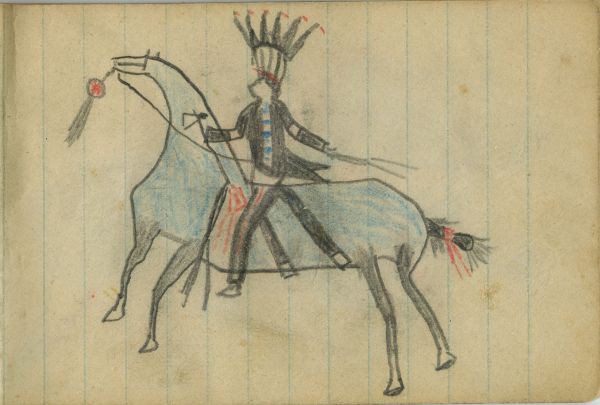WAR: Warrior in Upright Eagle Headdress on Blue Horse
Ethnographic Notes
This page, along with page 28, were drawn upside down in the ledger. Horizontal WAR: Warrior in Upright Eagle Headdress on Blue Horse The man is dressed in full military regalia, even though no enemy is in the drawing. The man wears an upright headdress of six visible immature golden eagle feathers, white with dark tips. Red tips on each feather are dyed horse hair or cow tail fur (Lanford: 2003, 172). The Cheyenne "crown" warbonnet , is so �tight� the �halo of feathers encircling the head was relatively smaller than in bonnets made by many other Plains Indians" (Lanford, 2003: 169-70; 191, Fig. 31). Red cloth at the crown's cap is represented by brief red lines. He wears a dark (lead pencil shaded) shirt with placard down the front decorated in blue (blue water color) and white alternating boxes (see Plate 24 for similar shirt ornamentation). His tunic-length shirttails fly behind him. The shirt is cuffed by German silver arm bands. His pants and breechclout are both dark saved-list trade cloth, with undyed edging for the clout; the vertical undyed stripe along the seam of the pants is colored red. The man holds a quirt in his outstretched left hand just over the horse�s rear. His right hand holds a tomahawk with two long, dark streamers. This same tomahawk appears in Plate 26 and others. Also attached to the butt of the weapon are red streamers and a small red bag. When Colonel Richard Irving Dodge wrote about Plains tribes, including the Cheyennes, in 1882, he noted: �Though there are yet many very elaborately ornamented tomahawks, they are regarded rather as an insignia of rank, to be carried on ceremonial occasions, but are scarcely thought of as weapons� (420). The blue roan horse (see previous plates for discussion of blue horses) also wears war regalia. The animal rises slightly on the page from right to left. It is blue with uncolored (white blaze) face, dark (lead pencil shaded) legs and uncolored hooves. Simple reins lead to the man�s waist. The horse has a scalp mounted the reins under his mouth�a round circle colored red with hair dangling. Michael Cowdrey writes about scalps hung near a horse's mouth on its "war bridle": "...scalps suspended near the mouth denote that these Thunderhorses will literally devour the enemy" (1999: 46). Benson L. Lanford writes of this practice: "A Victorious Warrior might hang a scalp that he had taken on the horse that had carried him into battle. The scalp conveyed to everyone the honor that he shared with his mount" (The Cheyenne/ Arapaho Ledger from the Pamplin Collection, 2003: 189). Another example is in the Northern Cheyenne-KSHS ledger, Plate 17. The horse's tail is clubbed, tied into a club shape, with red trade cloth.

